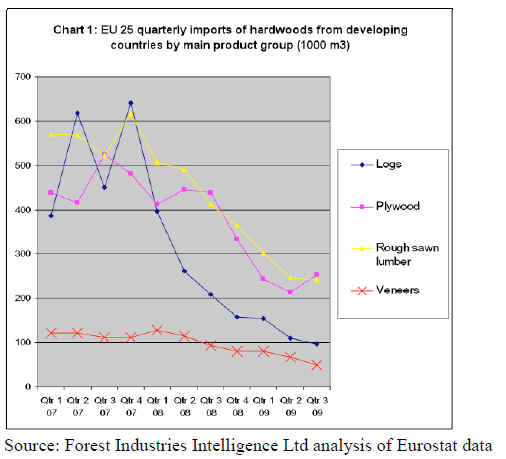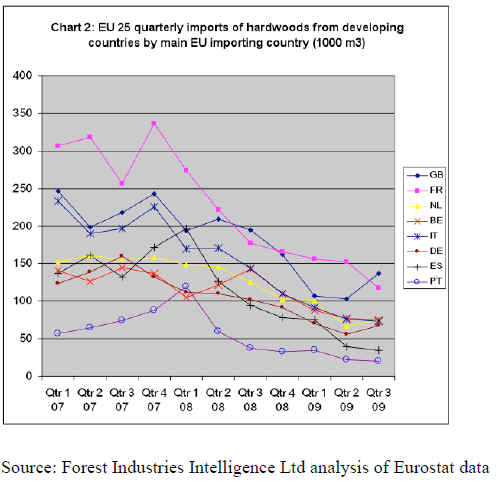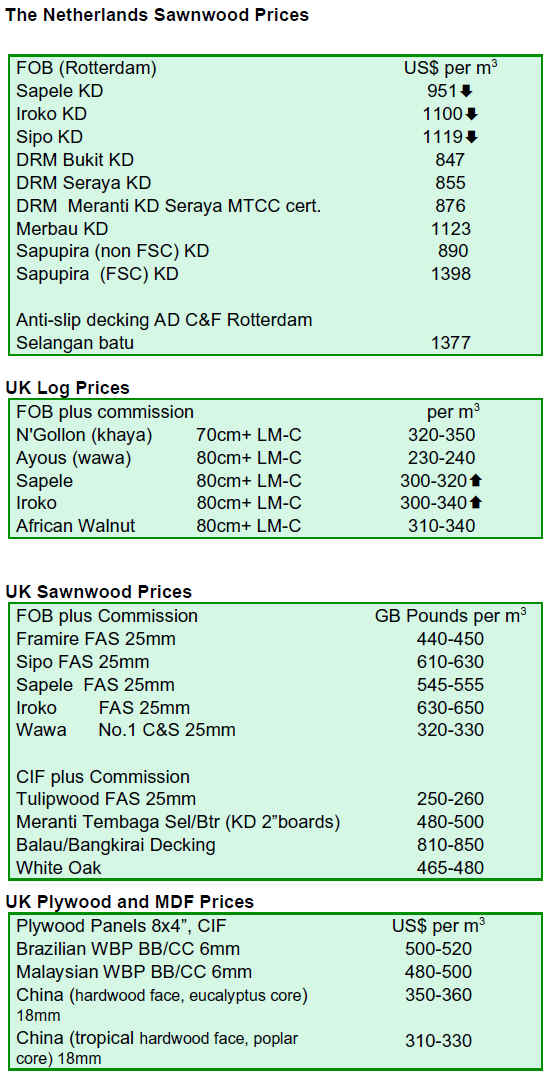|
Report
from
Europe, the UK
and
Russia
Rebound in EU plywood imports
Analysis of the most recent Eurostat trade data indicates
that European imports of hardwood-faced plywood from
developing countries rebounded in the third quarter of
2009 after suffering four consecutive quarters of decline.
In the three months to end September 2009, the EU
imported 252,000 cu.m of hardwood plywood from
developing countries compared to only 211,000 cu.m in
the previous 3 month period. This aligns with anecdotal
reports of European plywood importers taking tentative
steps to rebuild depleted stocks. Nevertheless, levels of
European hardwood plywood imports during the third
quarter of 2009 were only around 50% of levels recorded
during the same period in 2008 and 2007 (Chart 1).

EU imports of other hardwoods from developing countries
continued to decline during the third quarter of 2009.
European imports of hardwood logs and sawn lumber
from these countries suffered seven straight quarters of
decline between October 2007 and September 2009.
Hardwood log imports fell from over 600,000 cu.m in the
fourth quarter of 2007, to less than 100,000 in the three
months to end September 2009.
During the same period, EU imports of sawn lumber from
developing countries declined from over 600,000 cu.m to
around 250,000 cu.m. EU imports of hardwood veneer
from developing countries fell for six consecutive quarters
between January 2008 and September 2009, from 128,000
cu.m to 50,000 cu.m (Chart 2).

Compared to the previous quarter, the three month period
to end September 2009 saw a slight increase in total
imports by the UK, Netherlands, and Germany of
hardwood logs, lumber, veneers and plywood from
developing countries. However, total imports of these
commodities into all other major EU markets continued to
fall during the third quarter of 2009 (Chart 2).
All the main developing-world suppliers of hardwoods to
the EU with the exception of China and Malaysia
experienced a decline in European sales during the third
quarter of 2009.
EU imports of hardwood primary products from China and
Malaysia (mainly plywood) showed marginal gains during
the third quarter compared to the second quarter, although
the volumes involved remained well below those of the
previous year. During the third quarter of 2009, EU
imports of hardwoods from most major developing-world
supply countries were running at less than 50% of volumes
achieved during the same period in 2007.
Weak growth prospect for 2010
The unprecedented fall in EU hardwood imports in 2008
and 2009 reflects the dramatic economic downturn across
Europe. The sheer scale of the downturn took many
economists by surprise.
EU GDP is expected to have fallen by around 4% in 2009
according to the most recent European Commission
forecasts (in November 2009). This compares to a fall of
only 1.8% predicted at the start of the year.
Signs that the European economy may have reached
bottom began to emerge in the third quarter of 2009. The
euro-area economy crawled out of recession in the three
months to the end of September. GDP across the eurozone
rose by 0.4%, the first quarterly increase for more
than a year. While the European economy is expected to
return to growth in 2010, the indications are that the
rebound will be very weak across the continent.
Prospects are dampened by a wide range of factors
including: high and rising levels of unemployment; overcapacity
in the construction sector following the bursting
of property bubbles in several countries (notably Spain,
Ireland and the UK); the strength of the euro which is
undermining European competitiveness in export markets;
and the continuing unwillingness of European banks to
provide credit, particularly to smaller businesses and
households.
To make matters worse, many European governments
have to deal with very high fiscal deficits, greatly reducing
their ability to stimulate economic activity.
Governments now face a very difficult policy dilemma.
Public debt may spiral out of control unless taxes are
raised or spending cut. But if fiscal support is withdrawn
too quickly, the economy could tip back into recession. To
address this, European Union countries have agreed in
principle to an í░ambitiousí▒ tightening of fiscal policy, but
only from 2011. By then, it is hoped, the economy will be
strong enough to withstand it.
The bright spots
There are a couple of bright spots amidst the gloom for the
hardwood industry. Activity in the European joinery
sector, particularly windows, is receiving a boost from
government stimulus measures focused on improving the
energy efficiency of buildings in some countries, notably
Germany and France. Furthermore, in those countries like
the UK where the property bubble has burst and new
residential building is in the doldrums, maintenance and
renovation work is more stable as property owners are
choosing to í░improve rather than moveí▒.
Growth prospects vary
While the economic downturn has been universally felt
across Europe, its depth and the likely strength of the
rebound varies between countries.
GDP in Germany shrank by 5% in 2009 and is expected to
rebound only weakly in 2010. Unemployment is expected
to jump this year from 3.1 million to 4.5 million, a painful
rise that will dampen consumer confidence and spending.
A wide range of government measures have been
implemented in order to stimulate growth. One beneficiary
of particular relevance to the tropical hardwood sector is
the windows sector which is currently benefiting from
government subsidies to boost energy efficiency.
Tax cuts, including a reduction in VAT scheduled for
2010 may help boost consumption this year. However
stronger economic growth will be impaired as government
support in other areas, including in the labour and car
markets, comes to an end.
Due to high dependency on the financial sector, GDP fell
particularly dramatically in the UK during 2009, by
around 5.9% from peak to trough. The UK remained in
recession in the three month period to September 2009, the
most recent quarter for which data is available.
The expectation is that the UK economy dragged itself out
of recession in the last quarter of 2009, and GDP is
forecast to grow weakly in 2010, by around 0.4%
according to The Economist. Unemployment is continuing
to rise and is expected to peak at around 9% of the
workforce in 2010. UK housing market statistics have
improved somewhat at the beginning of 2010, for example
there was a 45% rise in new house registrations in the 3
months to November 2009.
On the other hand, prospects in the UK for 2010 are
dampened by wide expectations of rising interest rates
together with higher taxes after a general election expected
sometime between March and May 2010 as the new
government tries to rein in the countryí»s burgeoning fiscal
deficit.
Recent reports in the UK Timber Trades Journal suggest
many timber traders expect the UK market to continue to
í░bump along the bottomí▒ in 2010.
GDP in France is expected to grow by 0.9% in 2010. The
French government has been spending freely in an effort
to counteract the effects of the recession, supporting
employment and bringing forward planned public
investment projects. However this is at the cost of a
burgeoning budget deficit. While the economy has
stabilised there is unlikely to be any dynamism.
Tight fiscal policies in Italy leave little room for economic
stimulus. There also appears to be little appetite for
structural reform, suggesting Italy will not be well placed
to benefit from the global upturn and its economic position
in Europe will continue to weaken. Economic growth of
only 0.4% is expected in 2010.
The strong euro will be a brake on Italian competitiveness
in key export sectors, including furniture. Manufacturing
in the Italian wood processing sectors is well down.
During late 2009, industries focused on exports, such as
furniture, were reporting that sales had fallen by nearly
50% compared to the previous year. Traditionally Italian
wood importers carried relatively high stocks, but during
the current downturn companies have followed the trend
to greatly run down stocks and minimise forward orders.
A home-grown property bubble meant Spain was hit early
and very hard by the credit crunch. The construction sector
has collapsed, feeding through into a dramatic decline in
key wood processing and manufacturing sectors.
Spainí»s large door manufacturing sector has suffered from
widespread bankruptcies and production is believed to be
down by more than 50%. Prospects for any improvement
in Spainí»s economy in the short to medium term seem
poor. GDP is expected to decline by 0.8% in 2010, with no
return to growth until at least the last quarter of the year.
Unemployment and the budget deficit are expected to soar.

|